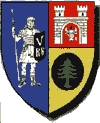Alternate names: SLATINA [ROM], STRIHARET/. 46°07' N 23°13' E, 182.0 miles NW of Bucureşti and 36 km NW of Alba Iulia in the Zlatna depression at the confluence of Ampoi River with Valea Morilor creek. (German: Schlatten, Goldenmarkt, Hungarian: Zalatna, Latin: Ampellum). A gold mining settlement during Roman times has a population of 8,607. [August 2009]
The town of Zlatna is made up of the town proper and 19 surrounding localities: Boteşti (Golddorf), Budeni (Higendorf), Bulbuc (Ochsenhirt), Dealu Roatei (Rotberg), Feneş (Wildendorf), Fântânele (Funtinel), Trâmpoiele (Trempojel), Izvoru Ampoiului (Gross-Ompeil), Galaţi (Galz), Presaca Ampoiului (Ober-Pressendorf), Pătrângeni (Peters), Podu lui Paul (Pauls), Părău Gruiului (Gruybach), Pirita (Pfirth), Runc (Goldrücken), Ruşi (Rusch), Suseni (Oberdorf), Valea Mică (Kleinwasser), and Vâltori (Waldrücken).
- JewishGen Romania SIG
- Pinkas HaKehilot, Romania, Vol. 1 (1969), p. 186: "Slatina".
- Encyclopedia of Jewish Life (2001), p. 1197: "Slatina".
CEMETERY:
US Commission No. ROCE-0019 -
The cemetery is located at Ampelum S.A., Zlatna, judet Alba, Transylvania, Romania. The alternate name is Zalathna (Hungarian.) 4607 2313, 17.9 miles WNW from Alba Iulia at 4604 2335 and 182.0 miles NW of Bucharest. Present town population is 25,000-100,000 with no Jews.
- Mayor Tregher Adrian
- The Jewish Community of Alba Iulia, Str. Tudor Vladimirescu no. 4, Alba Iulia, Romania. Phone: 00/40/58/817840
- The Federation of The Jewish Communities of Romania, Sfintu Vineri Street no. 9-11, sect. 3, Bucharest, Romania
- "Dr. Moshe Carmilly" Institute for Hebrew and Jewish History, Universitatii Street no. 7-9, room 61, 3400 Cluj-Napoca, Romania, Director: Ladislau Gyemant, This email address is being protected from spambots. You need JavaScript enabled to view it.
- "A.D. Xenopol" Institute of History, Lascar Catargi Street, no. 15, 6400- Iasi Judet Iasi, Moldavia , Romania. Tel. 032/212614; e-mail: This email address is being protected from spambots. You need JavaScript enabled to view it.. Director: Alexandru Zub.
- Key holder: Ampelum S.A. Zlatna
- Interested: Abraham Geza, Str. Tudor Vladimirescu no. 4, Alba Iulia, Romania. Phone: 00/40/58/817840
The Jewish population by census was seven in 1857, sixteen in 1880, and 26 in 1930. The cemetery was established in 19th century. Last known burial was 20th century. The unlandmarked Orthodox cemetery is 2 km. from the congregation that used it.
The isolated urban flat land has no sign or marker. Reached via private road, (Ampelum S.A.) access is open with permission. A masonry wall and a gate that locks surround the site. Approximate pre- and post-WWII size is 30 X 30 m. 1-20 stones are visible and in original location. All gravestones are in original location. More than 75% of the stones are toppled or broken. Location of stones removed from the cemetery is unknown. Vegetation overgrowth in the cemetery is not a problem. Water drainage is good all year. No special sections.
The oldest known gravestone dates from 19th century. The 19th and 20th century marble, limestone, and sandstone flat shaped, smoothed and inscribed, and carved relief-decorated gravestones have Hebrew and Hungarian inscriptions. Some have portraits on stones.
The national Jewish community owns the property used for industrial or commercial use.
Adjacent properties are commercial or industrial. Site probably is the same size as before 1939. Rarely, private Jewish or non-Jewish visitors stop the never vandalized cemetery with no maintenance or care. No structures.
Lucian Nastasă, Clinicilor Street, no. 19, Cluj, Romania, tel. 064/190107. Email: This email address is being protected from spambots. You need JavaScript enabled to view it. visited the site and completed the survey on 26 October 2000.
- Tr.Rotaru (coord.), Recensamintul din 1880. Transilvania, Cluj, Edit. Staff, 1997.
- -Kalman Weszpremy, A magyarorszagi zsidok statistikaja, Debrecen, 1907.
- Recensamintul general al populatiei Romaniei, 1930, vol.II, publicat de Sabin Manuila, Bucuresti, 1938.
- Lajos Venetianer, A magyar zsidosag tortenete, Budapest, 1922
- Carmilly-Weinberger, Moshe. Istoria evreilor din Transilvania (1623-1944), Bucuresti, Edit. Enciclopedica, 1994.
- Izvoare si marturii referitoare la evreii din Romania, I-III/1-2, Bucuresti, 1986-1999.
- Ladislau Gyemant, This email address is being protected from spambots. You need JavaScript enabled to view it., Evreii din Transilvania in epoca emanciparii (1790-1867), Bucuresti, Edit. Enciclopedica, 2000.
Lucian Nastasă interviewed Abraham Geza, Str. Tudor Vladimirescu no. 4, Alba Iulia, Romania. Phone: 00/40/58/817840 on 26 October 2000. [January 2003]
